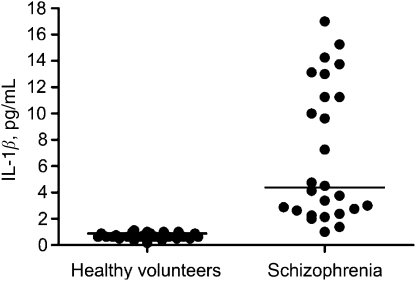The underlying pathophysiological cause of schizophrenia is essentially unknown. Increasing evidence suggests that immunological processes may contribute to the etiology of the disease. Owing to the lack of direct evidence of an infectious cause of schizophrenia much attention has been directed towards cytokines; molecules that initiate immunological responses. However, previous studies measuring the level of cytokines in the serum of patients with schizophrenia have provided an inconsistent picture in this regard.1 The relatively few studies focusing on the level of cytokines in the cerebrospinal fluid (CSF) have been limited to a restricted number of cytokines analysed, to the lack of a control group of healthy volunteers or to the sensitivity of the cytokine assays used. Here, a sensitive assay was used to analyse the CSF concentration of well-characterized cytokines in first-episode patients with schizophrenia and age-matched healthy volunteers.
Lumbar punctures were carried out on twenty-six infection-free, first-episode male Caucasians who later were diagnosed with schizophrenia (DSM-IV). Patients were treated with various antipsychotics from the day of hospitalization to lumbar puncture (about three weeks). Thirty healthy male Caucasian volunteers served as controls. Cytokines were analysed using a sandwich-immunoassay-based protein-array system, see Supplementary Materials.
Interleukin (IL)-1β, IL-6 and IL-8 were reliably detectable in CSF of both patients and controls. IL-2, IL-4, IL-5, IL-10, granulocyte–macrophage-colony stimulating factor, interferon-γ and tumour necrosis factor-α were found in low concentrations (median <0.5 pg/ml) or were undetectable in both patients and controls. In patients, IL-1β concentrations were markedly elevated (median 4.37 pg/ml) compared with controls (median 0.78 pg/ml; Figure 1). Analysis of IL-6 and IL-8 showed no significant difference between patients (median 2.53 and 64.6 pg/ml, respectively) and controls (median 2.52 pg/ml and 89.0 pg/ml, respectively). No correlations were observed between cytokine concentrations and age, smoking or length/dosage of antipsychotic medication.
Figure 1.
Interleukin (IL)-1β in cerebrospinal fluid from healthy volunteers (mean age 25.4±7.2 years) and patients with schizophrenia (mean age 27.5±6.6 years). Each point represents the concentration of IL-1β (pg/ml) in a single cerebrospinal fluid (CSF) sample. Horizontal lines show median values for each group. The 75 percentiles are 0.97 (healthy volunteers) and 12.2 (patients with schizophrenia). P<0.0001 (Mann–Whitney U-test).
These results provide evidence for the activation of the brain immune system in first-episode schizophrenia. This is in contrast to previous studies examining CSF of chronic patients with regard to IL-1β.2 Possibly, the elevation of IL-1β may be normalized or downregulated along the disease progress or during prolonged antipsychotic treatment. Whether the elevation of IL-1β is congenital, acquired during prodromal phase or absent until the time of first psychotic episode remains to be elucidated.
Like other cytokines, IL-1β is released from microglia and astrocytes. However, as serum cytokines may access brain for example, through saturable carriers or a damaged blood brain barrier,3 a peripheral contribution to CSF IL-1β levels should not be excluded. It should be noted that the selective elevation of IL-1β observed differs from the general activation of pro-inflammatory cytokines seen during a CNS infection and from the typical cytokine profile observed during an autoimmune response.
During infection, pro-inflammatory cytokines, including IL-1β are suggested to induce sickness behaviour for example, lethargy, anhedonia, cognitive impairment and social withdrawal.4 Similar symptoms are also referred to as negative symptoms and cognitive deficits in schizophrenia. Schizophrenia is generally attributed to a dysfunction of brain dopaminergic and glutamatergic circuits. Interestingly, administration of IL-1β to rats is associated with an increased and decreased dopamine concentration in the nucleus accumbens5 and prefrontal cortex, respectively,6 conditions proposed to occur simultaneously in schizophrenia. With respect to glutamate neurotransmission the action of IL-1β seems complex and diversified, including both excitatory and inhibitory components. These involve direct actions on the intercellular brain signalling7 as well as effects with delayed onset, like altered expression of genes encoding the enzymes regulating glutamate neurotransmission.8 Clearly, IL-1β possesses properties possibly causing a dopaminergic and glutamatergic dysregulation as proposed to occur in schizophrenia.
This is the first study showing a marked elevation of IL-1β in CSF of male patients with first-episode schizophrenia. Regardless of whether such activation of the brain immune system is of infectious, genetic or other origin it is clearly associated with the onset of schizophrenia. Present data are interesting in view of genetic studies showing an association of polymorphisms in the IL-1 gene cluster in schizophrenia.9, 10 Our results may open up new therapeutic strategies in the treatment of the disease. However, it remains to be established if the activation of IL-1β is causally related to the development of schizophrenia or is tentatively a consequence of the dopaminergic/glutamatergic dysfunctions that characterize the disease.
Conflict of interest
The authors declare no conflict of interest.
Supplementary Material
Supplementary Information accompanies the paper on the Molecular Psychiatry website (http://www.nature.com/mp)
References
- Potvin S, Stip E, Sepehry AA, Gendron A, Bah R, Kouassi E. Biol Psychiatry. 2008. pp. 801–808. [DOI] [PubMed]
- Barak V, Barak Y, Levine J, Nisman B, Roisman I. J Basic Clin Physiol Pharmacol. 1995. pp. 61–69. [DOI] [PubMed]
- Quan N, Banks WA. Brain Behav Immun. 2007. pp. 727–735. [DOI] [PubMed]
- Dantzer R, Kelley KW. Brain Behav Immun. 2007. pp. 153–160. [DOI] [PMC free article] [PubMed]
- Song C, Li X, Kang Z, Kadotomi Y. Neuropsychopharmacology. 2007. pp. 736–744. [DOI] [PubMed]
- Song C, Manku MS, Horrobin DF. J Nutr. 2008. pp. 954–963. [DOI] [PubMed]
- Viviani B, Gardoni F, Marinovich M. Int Rev Neurobiol. 2007. pp. 247–263. [DOI] [PubMed]
- Pickering M, O'Connor JJ. Prog Brain Res. 2007. pp. 339–354. [DOI] [PubMed]
- Papiol S, Rosa A, Gutiérrez B, Martín B, Salgado P, Catalán R, et al. J Med Genet. 2004. pp. 219–223. [DOI] [PMC free article] [PubMed]
- Hänninen K, Katila H, Saarela M, Rontu R, Mattila KM, Fan M, et al. Eur Arch Psychiatry Clin Neurosci. 2008. pp. 10–15. [DOI] [PubMed]
Associated Data
This section collects any data citations, data availability statements, or supplementary materials included in this article.



